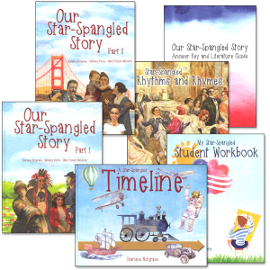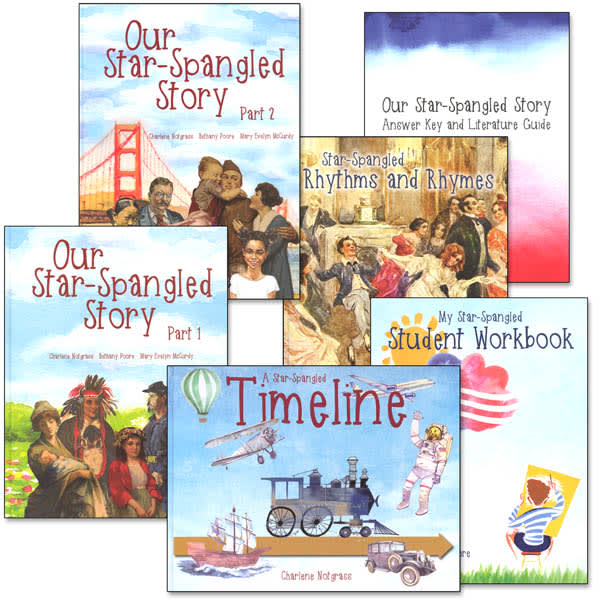Our Star-Spangled Story is a year-long U.S. history course for grades one through four that reflects a Christian worldview and patriotic attitudes. It has many elements of a unit study since, along with the study of history, it incorporates literature, music, creative writing, geography, and art. In addition, coloring, drawing, singing, dancing, arts, crafts, games, recipes, and projects reinforce learning and help address children’s different learning styles.
The course consists of six books published by Notgrass plus eight storybooks you can borrow from the library or purchase. The Notgrass course books are:
- Our Star-Spangled Story: Part 1 and Part 2 (two separate books)
- Star-Spangled Rhythms and Rhymes – book with a CD (with MP3 files). Both contain the same 60 songs, poems, and dances.
- A Star-Spangled Timeline – a visual reference book that shows images of key people and events chronologically on a timeline
- My Star-Spangled Student Workbook – with a colorful activity page for each of the 90 lessons
- Our Star-Spangled Story Answer Key and Literature Guide – answer key plus notes and discussion questions for the eight storybooks
All these books except the Answer Key and Literature Guide are very attractively illustrated and printed in full color. The first four books are hardcover. If you are teaching more than one student, each one needs only an additional student workbook.
The course is taught from Our Star-Spangled Story: Part 1 and Part 2. Each book has more than 300 pages, which explains why the course is split into two books. Beginning with the first European settlers of America and Native American cultures, the course continues up through the present day. Rather than trying to cover U.S. history in a comprehensive fashion, much of the time it uses stories of historical people in relation to significant events. For example, Lesson 72: Walking to School with Ruby Bridges, relates the story of a six-year-old African-American girl who was one of the first to attempt to act on the Supreme Court decision in Brown v. Board of Education to attend a school reserved for white children only. This lesson continues with an explanation of the civil rights movement, including brief information about Rosa Parks and Dr. Martin Luther King Jr.
The two coursebooks together have 30 units, with three lessons per unit. The intent is for lessons to take place three days per week, but parents can spread lessons out over five days if they wish.
Each lesson presents the text information first, with all the other activities listed at the end. Parents can read the text aloud to children, and older children can read it for themselves. The reading should take only about 15 minutes per day. There are three sections for the activities: Lesson Activities, Review Questions, and Hands-On History Ideas.
Under Lesson Activities are three or four of the following: map activities (using maps at the front and back of each book), Rhythms and Rhymes activities, a page in the student workbook to complete, a storybook to be read, and pages in the timeline book to explore.
The Review Questions should be used for discussion. Hands-On History Ideas are generally a pretend scenario and a building blocks activity, although sometimes they refer to a unit project. Pretend scenarios are presented like this one from page 127: “Pretend you are Daniel Boone or a member of his family, exploring, hunting, trapping, and preparing the way for new settlers.” The same lesson also suggests that students use building blocks to construct a wilderness fort. Unit projects (found at the end of each unit) are for crafts, games, recipes, or projects such as creating a care package. Since each unit takes one week to complete, you will have one of these projects every week. The time required for activities and projects can vary greatly, and some families might choose to skip some or substitute ideas of their own.
The eight storybooks used with the course are:
- Benjamin West and His Cat Grimalkin
- Toliver’s Secret
- Freedom Crossing
- Farmer Boy
- Mountain Born
- Emily’s Runaway Imagination
- The Year of Miss Agnes
- Katy
The storybooks were selected to support lesson content, so they must be read at the points designated within the course books.
While the lessons and end-of-lesson activities are “open and go,” the projects require planning ahead to gather resources. A Unit Projects Supply List is available on the Notgrass website along with other extras such as a list of additional suggested literature; video demonstrations of singing, games, and dances; downloadable files required for two projects; and printable maps.
Homeschool History Supplements
Notgrass Homeschool History continually adds to their database of history-related resources that support their courses. Supplemental content for each course is available free for almost every lesson. But you can also subscribe to Homeschool History to access all their search and filtering features. There are three primary search tools: Resource, Map, and Topic. A Resource search lets you search by keyword, age range, and type of resource: audio/music, book, curriculum supplement, destination, game, hands-on, interview, printable, unit study, video, and website (with parental warnings if there is potentially problematic content). The Map search tool helps you find places around the world for both physical and virtual field trips. Topic searches let you search by regions of the world, eleven categories (e.g., culture, military, government), by alphabetical or chronological order, and by time period. As you identify resources to use from these searches, you can create your own bookmarked group of items.
Summary
Our Star-Spangled Story is perfectly suited to the homeschool environment and offers a well-designed blend of easy-to-use textbooks with storybooks, activities, and projects. In addition, the underlying Christian worldview and positive attitudes toward America are likely to be well received by many homeschooling families.











